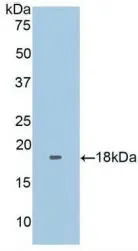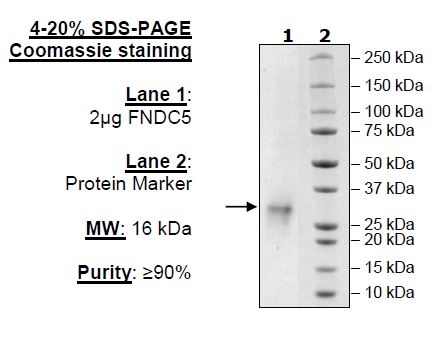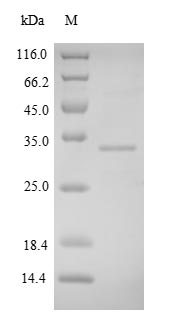
Protein structure of Fc (LALA-PG)-KIH (human):Irisin (monomeric) (rec.) (Prod. No. AG-40B-0246).
Fc (LALA-PG)-KIH (human):Irisin (monomeric) (rec.)
AG-40B-0246
Protein IDQ8NAU1
Product group Proteins / Signaling Molecules
Overview
- SupplierAdipoGen Life Sciences
- Product NameFc (LALA-PG)-KIH (human):Irisin (monomeric) (rec.)
- Delivery Days Customer10
- CertificationResearch Use Only
- Concentration1 mg/ml
- Estimated Purity>95%
- Protein IDQ8NAU1
- Protein NameFibronectin type III domain-containing protein 5
- Scientific DescriptionInVivoKines™. Recombinant protein. Fc (LALA-PG) Knobs:Irisin (human, aa 32-143 /mouse, aa 29-140) and Fc (LALA-PG) Holes form the Fc (LALA-PG)-KIH (human):Irisin (monomeric) (rec.) using the Knobs-into-Holes technology (see reference: J.B. Ridgway, et al.; Protein Eng. 9, 617 (1996)). Source: HEK 293 cells. Lyophilized. Contains PBS Irisin is a recently described exercise-induced hormone secreted by skeletal muscle in mice and humans. Irisin activates beige fat cells (beige cells have a gene expression pattern distinct from either white or brown fat and are preferentially sensitive to the polypeptide hormone Irisin). Irisin is cleaved from the type I membrane protein FNDC5 and improves systemic metabolism by increasing energy expenditure. Upon exercise, FNDC5 expressed by skeletal muscles is proteolytically processed and secreted as the myokine Irisin, which has several functions: i) it contributes to the conversion of white fat to higher oxygen consumable brown fat (also called beige fat) in response to exercise; ii) it regulates bone mineral density and bones remodeling; and iii) it increases synaptic plasticity and rescues memory and cognitive function of the brain in mouse models of Alzheimers disease. Irisin not only plays a vital role in energy metabolism but also has crucial roles in a variety of processes such as inflammation, proliferation, metastasis, aging and neural differentiation. The protein Fc (LALA-PG)-KIH (human):Irisin (monomeric) (rec.) is produced by using two different vectors, one encoding for the Fc Knobs (LALA-PG) (human):Irisin sequence (synthesizing a protein of 55kDa) and one encoding for the Fc Holes (LALA-PG) sequence (synthesizing a protein of 30kDa). Both vectors transfected into HEK293 cells produce both Fc molecules (Knobs-into-Holes technology; J.B. Ridgway, et al.; Protein Eng. 9, 617 (1996)) required for dimerization and for secretion of the final protein Fc (LALA-PG)-KIH (human):Irisin (monomeric) (rec.). The Fc contains the mutations LALA-PG that abolish the interaction between the Fc and FcgammaRs and therefore Fc undesirable effects. - Irisin is a recently described exercise-induced hormone secreted by skeletal muscle in mice and humans. Irisin activates beige fat cells (beige cells have a gene expression pattern distinct from either white or brown fat and are preferentially sensitive to the polypeptide hormone Irisin). Irisin is cleaved from the type I membrane protein FNDC5 and improves systemic metabolism by increasing energy expenditure. Upon exercise, FNDC5 expressed by skeletal muscles is proteolytically processed and secreted as the myokine Irisin, which has several functions: i) it contributes to the conversion of white fat to higher oxygen consumable brown fat (also called beige fat) in response to exercise; ii) it regulates bone mineral density and bones remodeling; and iii) it increases synaptic plasticity and rescues memory and cognitive function of the brain in mouse models of Alzheimers disease. Irisin not only plays a vital role in energy metabolism but also has crucial roles in a variety of processes such as inflammation, proliferation, metastasis, aging and neural differentiation. The protein Fc (LALA-PG)-KIH (human):Irisin (monomeric) (rec.) is produced by using two different vectors, one encoding for the Fc Knobs (LALA-PG) (human):Irisin sequence (synthesizing a protein of 55kDa) and one encoding for the Fc Holes (LALA-PG) sequence (synthesizing a protein of 30kDa). Both vectors transfected into HEK293 cells produce both Fc molecules (Knobs-into-Holes technology; J.B. Ridgway, et al.; Protein Eng. 9, 617 (1996)) required for dimerization and for secretion of the final protein Fc (LALA-PG)-KIH (human):Irisin (monomeric) (rec.). The Fc contains the mutations LALA-PG that abolish the interaction between the Fc and FcgammaRs and therefore Fc undesirable effects. InVivoKines™ are a new generation of recombinant fusion proteins for immunotherapeutic, preclinical and translational in vivo research, developed and manufactured by AdipoGen Life Sciences.
- Storage Instruction-20°C,2°C to 8°C
- UNSPSC12352202





